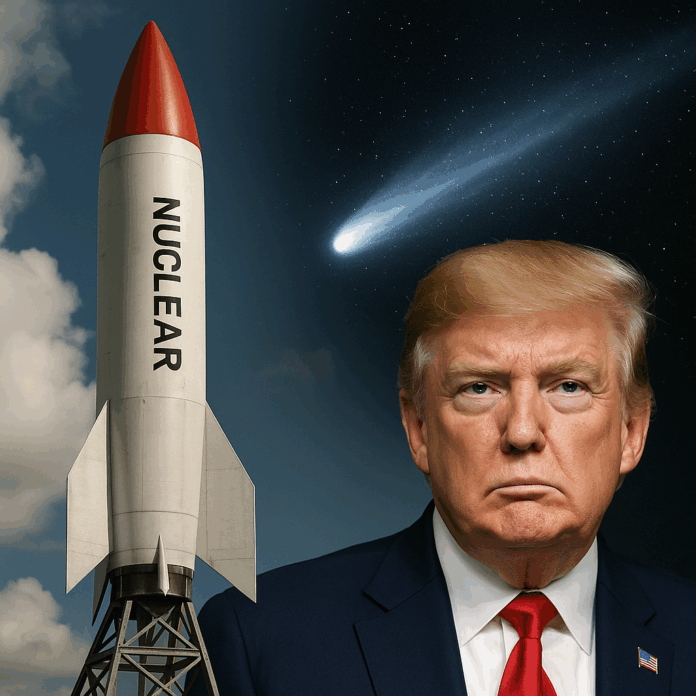
Key Takeaways
1) IAWN just opened a formal “comet campaign” on 3I/ATLAS, elevating astrometric tracking to stress-test the world’s warning network.
2) DART proved kinetic deflection is real, giving policymakers a non-nuclear playbook while nuclear posturing resurges.
3) Trump’s order to restart U.S. nuclear testing reframes space-hazard preparedness inside a broader full-spectrum deterrence environment, even as space-nuke bans remain in force.
By Samuel Lopez | USA Herald
WASHINGTON, DC – The International Asteroid Warning Network (IAWN) has put 3I/ATLAS (C/2025 N1) on center stage. In a notice posted this month, IAWN announced a Nov. 27, 2025–Jan. 27, 2026 observing campaign focused on extracting highly accurate comet astrometry.
In plain terms, it is a live-fire drill for precision tracking—aimed at improving how quickly and cleanly the global community can nail down an interstellar object’s position and trajectory. That decision places the third known interstellar visitor under coordinated, worldwide scrutiny just as it slings past the Sun and continues outbound. IAWN
Running in parallel, the United States has a standing, public strategy for planetary defense. NASA’s Planetary Defense Strategy and Action Plan (and the White House’s companion national plan) outline how agencies coordinate detection, characterization, and—if ever required—deflection.
The most tangible proof point is DART, which struck the moonlet Dimorphos on Sept. 26, 2022 and measurably shortened its orbit—first-ever confirmation that a kinetic impactor can alter a small body’s motion. These documents and results anchor non-nuclear responses to natural impact threats and define the institutional muscle memory that IAWN’s new campaign is exercising. NASA Planetary Defense Strategy and Action Plan
Into this already active posture came President Trump’s Oct. 29, 2025 directive to resume U.S. nuclear weapons testing, framed as matching Russia and China “on an equal basis.”
“The United States has more Nuclear Weapons than any other country. This was accomplished, including a complete update and renovation of existing weapons, during my First Term in office. Because of the tremendous destructive power, I HATED to do it, but had no choice! Russia is second, and China is a distant third, but will be even within 5 years. Because of other countries testing programs, I have instructed the Department of War to start testing our Nuclear Weapons on an equal basis. That process will begin immediately. Thank you for your attention to this matter! PRESIDENT DONALD J. TRUMP.” Announced on Truth-Social.
Regardless of timing or ultimate test logistics, the order broadens the deterrence tableau: civil planetary-defense infrastructure is being tuned for interstellar target-tracking while strategic forces posture against terrestrial adversaries.
It is tempting to read deliberate choreography into the calendar—IAWN goes public with a precision-tracking drill on an interstellar object, then Washington signals a return to nuclear testing for the first time since the early 1990s.
The more sober read is that the two tracks are formally separate but mutually reinforcing in narrative: one is an open, international, scientific rehearsal to refine how we measure threats from space; the other is a national-security signal sent to state actors here on Earth.
For policymakers, the operational takeaway is that IAWN’s measurements and NASA’s planetary-defense architecture offer transparent, confidence-building guardrails: if a hazardous body appeared, the world would have shared math first.
DART’s proof-of-concept supplies a non-nuclear response option, while the renewed nuclear-testing rhetoric—however it develops procedurally—operates in a different lane aimed at human adversaries, not interstellar rocks. That bifurcation matters for law and diplomacy: it preserves the long-standing prohibition against nuclear detonations in space while strengthening civil-science cooperation under IAWN and the PDCO.
Seen together, 3I/ATLAS is serving as a real-time systems test. The timing may be politically noisy, but the substance is technical: better astrometry, validated deflection physics, and clearer doctrine lines between scientific planetary defense and strategic deterrence. If 3I/ATLAS passes uneventfully, the exercise still pays dividends—delivering faster orbit solutions, cleaner error bars, and practiced coordination that will matter on the day a trajectory truly points our way.


